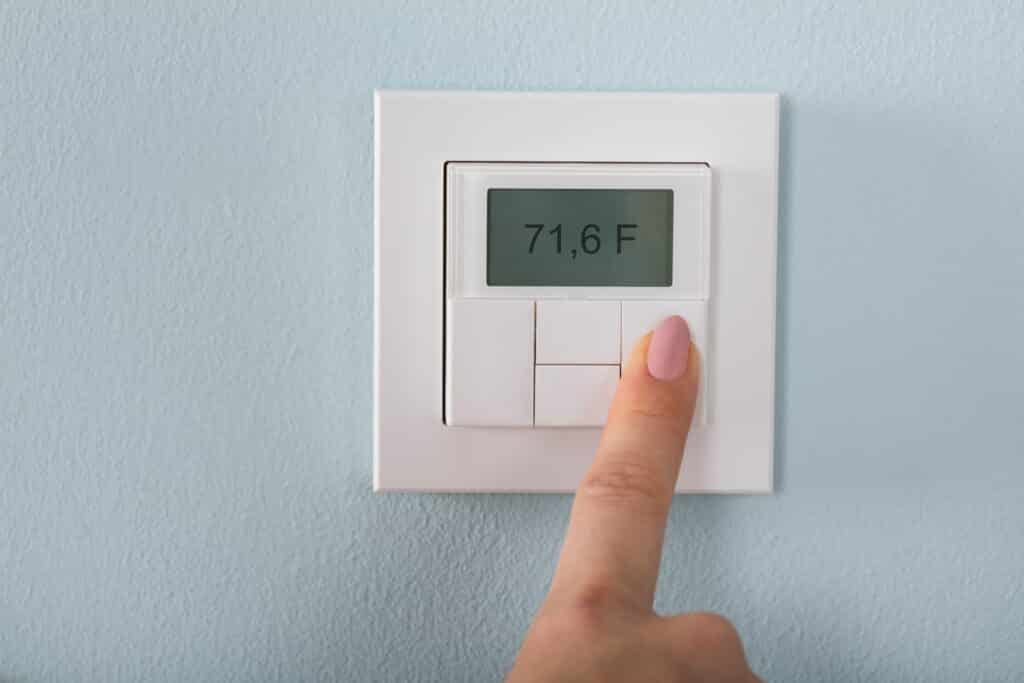- Thermostats regulate your home’s temperature and improve comfort and energy efficiency, with options like manual, programmable, and Wi-Fi models available to suit your needs.
- Key features to consider when choosing a thermostat include ease of use, energy efficiency, compatibility with your HVAC system, and smart features for added convenience.
- Professional installation and regular maintenance make sure your thermostat functions optimally, providing long-term comfort and energy savings for your home.
Thermostats are the heart of your home’s heating and cooling system. They regulate your indoor temperature, making sure your space remains comfortable throughout the year. Setting the thermostat to your ideal temperature keeps you comfortable and improves your system’s efficiency.
Let’s take a closer look at how thermostats work and how to choose the best for your home.
What Is a Thermostat?
A thermostat controls your home’s temperature and adjusts your HVAC system settings. It helps you maintain the perfect temperature in your home by regulating heating and cooling.
Once you set the temperature you want, the thermostat takes over. It constantly monitors the temperature in your home and signals your HVAC system to adjust as needed. If the room is too hot, the thermostat triggers the cooling system to lower the temperature. If it’s too cold, it activates the heating system to warm the space.
Thermostats come in different types, but they all have a few key parts: a sub-base, the main device, and sometimes extra sensors for added accuracy. With the right thermostat, you can easily control your home’s climate for comfort and efficiency.
Types of Thermostats
Choosing the right thermostat depends on your needs, lifestyle, and home setup. Here’s a breakdown of the different thermostat types to help you make an informed decision that fits your preferences.
Manual Thermostats
Manual thermostats are as simple as it gets. These basic devices use a dial or lever to adjust the temperature. You turn the knob to your desired setting, and it controls the temperature until you decide to change it. While these thermostats are easy to use, they don’t come with additional features. If you prefer something straightforward without any added complexity, a manual thermostat might be a good choice.
Non-Programmable Thermostats
If you’re looking for a simple and budget-friendly option, non-programmable thermostats are a great choice. You can easily adjust the temperature whenever you need it, without worrying about pre-set schedules. These thermostats control heating and cooling systems and come with a constant fan setting to keep the air circulating throughout your home. They offer reliable temperature control with minimal effort, making them a solid option for those who prefer manual adjustments but still want a dependable thermostat.
Programmable Thermostats
Programmable thermostats take convenience a step further. These devices allow you to set different temperatures for different times of the day.
For example, you can program it to lower the temperature while you’re asleep and raise it again before you wake up. This feature is great for saving energy and ensuring comfort at all times. Many programmable thermostats let you set schedules for each day of the week, giving you plenty of flexibility.
With these devices, you don’t have to constantly adjust the temperature, which means less work and more savings on your energy bills.
Wi-Fi Thermostats
Wi-Fi thermostats are the most advanced on the market. They connect to your home’s Wi-Fi, which allows you to control the temperature from anywhere using a smartphone app. For example, they can send you automatic notifications if your home’s temperature falls below a certain level, helping you avoid issues like frozen pipes. These thermostats can also detect extreme temperatures and adjust early to make sure your home stays comfortable. With Wi-Fi thermostats, you get convenience, flexibility, and smart control.
Key Features to Look for in a Thermostat

Since you now know the different types of thermostats, the next step is to identify which one suits your home and needs best. Here are some key features to look for when choosing the right thermostat for you:
- Ease of Use: Whether you opt for a manual, programmable, or smart thermostat, you want one that’s easy to set up and use. Look for a thermostat with an intuitive interface, whether it’s a dial, a touchscreen, or app controls. Simple controls will make sure you can make adjustments effortlessly.
- Energy Efficiency: Choose a thermostat that helps you save on energy costs. Programmable and smart thermostats excel in this area by allowing you to set schedules and adjust temperatures automatically based on your routine. This helps avoid unnecessary heating or cooling when you don’t need it, reducing energy waste.
- Compatibility with Your HVAC System: Make sure the thermostat you select works with your HVAC system. Some thermostats only fit specific systems like forced air or radiant heating systems. Check compatibility before purchasing to guarantee smooth and efficient operation.
- Smart Features: Advanced features in modern thermostats make controlling your home’s comfort effortless. You can integrate them with voice assistants like Amazon Alexa or Google Home to adjust the temperature using simple commands. Some even use your location to make sure your home feels perfect when you walk in the door. These features combine convenience and energy efficiency seamlessly.
- Temperature Sensors: Some thermostats come with additional sensors that can monitor the temperature in different rooms or zones of your home. This feature helps make sure that your home stays uniformly comfortable, regardless of room size or where you spend the most time.
- Budget-Friendly Options: While smart thermostats are high-tech and convenient, they tend to come at a higher price point. If you’re on a budget, manual or non-programmable thermostats might be more cost-effective while still offering reliable temperature control for your home.
Professional Installation and Maintenance
When installing and maintaining your thermostat, it’s a good idea to rely on a professional. An expert will make sure that the thermostat works perfectly with your HVAC system, so you can get the most out of it. HVAC technicians can also calibrate the thermostat for accurate readings, guaranteeing your home stays at the right temperature.
They can also help with regular maintenance. Checking the batteries, recalibrating settings, and making sure the thermostat continues to run smoothly will keep everything in top condition. Letting a professional take care of these tasks gives you peace of mind, knowing your thermostat will function properly for years ahead.
Ready to Upgrade Your Thermostat?
Whether you’re looking for better temperature control, energy savings, or improved comfort, a new thermostat is an investment that pays off. From simple manual models to advanced smart thermostats, there’s a device for every need. Don’t wait for your system to cost more than it should. Upgrade today and enjoy a more efficient, comfortable home tomorrow.
At Quality Heating, Cooling, Plumbing & Electric, we offer expert installation and maintenance services for all types of thermostats. Our experienced technicians can help you choose the perfect thermostat for your home and ensure it’s installed correctly for maximum efficiency. Contact us today to get started!




0 Comments